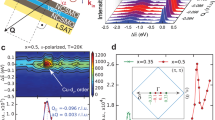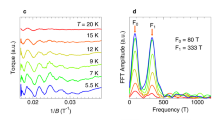Abstract
In high-Tc superconductors the magnetic and electronic properties are determined by the probability that valence electrons jump virtually from site to site in the CuO2 planes, a mechanism opposed by on-site Coulomb repulsion and favoured by hopping integrals. The spatial extent of the latter is related to transport properties, including superconductivity, and to the dispersion relation of spin excitations (magnons). Here, for three antiferromagnetic parent compounds (single-layer Bi2Sr0.9La1.1CuO6+δ, double-layer Nd1.2Ba1.8Cu3O6 and infinite-layer CaCuO2) differing by the number of apical atoms, we compare the magnetic spectra measured by resonant inelastic X-ray scattering over a significant portion of the reciprocal space and with unprecedented accuracy. We observe that the absence of apical oxygens increases the in-plane hopping range and, in CaCuO2, it leads to a genuine three-dimensional (3D) exchange-bond network. These results establish a corresponding relation between the exchange interactions and the crystal structure, and provide fresh insight into the materials dependence of the superconducting transition temperature.
This is a preview of subscription content, access via your institution
Access options
Access Nature and 54 other Nature Portfolio journals
Get Nature+, our best-value online-access subscription
$29.99 / 30 days
cancel any time
Subscribe to this journal
Receive 12 print issues and online access
$209.00 per year
only $17.42 per issue
Buy this article
- Purchase on Springer Link
- Instant access to full article PDF
Prices may be subject to local taxes which are calculated during checkout




Similar content being viewed by others
References
Ogata, M. & Fukuyama, H. The t-J model for the oxide high-Tc superconductors. Rep. Prog. Phys. 71, 036501 (2008).
Scalapino, D. J. A common thread: the pairing interaction for unconventional superconductors. Rev. Mod. Phys. 84, 1383–1417 (2012).
Mallett, B. P. P. et al. Dielectric versus magnetic pairing mechanisms in high-temperature cuprate superconductors investigated using Raman scattering. Phys. Rev. Lett. 111, 237001 (2013).
Munoz, D., Illas, F., Moreira, I. & de, P. R. Accurate prediction of large antiferromagnetic interactions in high-Tc HgBa2Can−1CunO2n+2+δ (n = 2, 3) superconductor parent compounds. Phys. Rev. Lett. 84, 1579–1582 (2000).
Ellis, D. S. et al. Correlation of the superconducting critical temperature with spin and orbital excitation energies in (CaxLa1−x)(Ba1.75−xLa0.25+x)Cu3Oy as measured by resonant inelastic X-ray scattering. Phys. Rev. B 92, 104507 (2015).
Eisaki, H. et al. Effect of chemical inhomogeneity in bismuth-based copper oxide superconductors. Phys. Rev. B 69, 064512 (2004).
Coldea, R. et al. Spin waves and electronic interactions in La2CuO4 . Phys. Rev. Lett. 86, 5377–5380 (2001).
Plumb, K. W., Savici, A. T., Granroth, G. E., Chou, F. C. & Kim, Y.-J. High-energy continuum of magnetic excitations in the two-dimensional quantum antiferromagnet Sr2CuO2Cl2 . Phys. Rev. B 89, 180410(R) (2014).
Braicovich, L. et al. Magnetic excitations and phase separation in the underdoped La2−xSrxCuO4 superconductor measured by resonant inelastic X-ray scattering. Phys. Rev. Lett. 104, 077002 (2010).
Ament, L. J. P., Ghiringhelli, G., Moretti Sala, M., Braicovich, L. & van den Brink, J. Theoretical demonstration of how the dispersion of magnetic excitations in cuprate compounds can be determined using resonant inelastic X-ray scattering. Phys. Rev. Lett. 103, 117003 (2009).
Guarise, M. et al. Measurement of magnetic excitations in the two-dimensional antiferromagnetic Sr2CuO2Cl2 insulator using resonant X-ray scattering: evidence for extended interactions. Phys. Rev. Lett. 105, 157006 (2010).
Lebert, B. W. et al. Resonant inelastic X-ray scattering study of spin-wave excitations in the cuprate parent compound Ca2CuO2Cl2 . Phys. Rev. B 95, 155110 (2017).
Le Tacon, M. et al. Intense paramagnon excitations in a large family of high-temperature superconductors. Nat. Phys. 7, 725–730 (2011).
Dean, M. P. M. et al. Persistence of magnetic excitations in La2−xSrxCuO4 from the undoped insulator to the heavily overdoped non-superconducting metal. Nat. Mater. 12, 1019–1023 (2013).
Minola, M. et al. Collective nature of spin excitations in superconducting cuprates probed by resonant inelastic X-Ray scattering. Phys. Rev. Lett. 114, 217003 (2016).
Headings, N. S., Hayden, S. M., Coldea, R. & Perring, T. G. Anomalous high-energy spin excitations in the high-Tc superconductor-parent antiferromagnet La2CuO4 . Phys. Rev. Lett. 105, 247001 (2010).
Dalla Piazza, B. et al. Unified one-band Hubbard model for magnetic and electronic spectra of the parent compounds of cuprate superconductors. Phys. Rev. B 85, 100508(R) (2012).
Pavarini, E., Dasgupta, I., Saha-Dasgupta, T., Jepsen, O. & Andersen, O. K. Band-structure trend in hole-doped cuprates and correlation with Tc, max . Phys. Rev. Lett. 87, 047003 (2001).
Peng, Y. Y. et al. Disappearance of nodal gap across the insulator-superconductor transition in a copper-oxide superconductor. Nat. Commun. 4, 2459 (2013).
Salluzzo, M. et al. Thickness effect on the structure and superconductivity of Nd1.2Ba1.8Cu3Oz epitaxial films. Phys. Rev. B 72, 134521 (2005).
Di Castro, D. et al. Occurrence of a high-temperature superconducting phase in (CaCuO2)n/(SrTiO3)m superlattices. Phys. Rev. B 86, 134524 (2012).
Reznik, D. et al. Direct observation of optical magnons in YBa2Cu3O6.2 . Phys. Rev. B 53, R14741 (1996).
Hayden, S. M., Aeppli, G., Perring, T. G., Mook, H. A. & Doğan, F. High-frequency spin waves in YBa2Cu3O6.15 . Phys. Rev. B 54, R6905 (1996).
Dalla Piazza, B. et al. Fractional excitations in the square-lattice quantum antiferromagnet. Nat. Phys. 11, 62–68 (2014).
Ho, C. M., Muthukumar, V. N., Ogata, M. & Anderson, P. W. Nature of spin excitations in two-dimensional Mott insulators: undoped cuprates and other materials. Phys. Rev. Lett. 86, 1626–1629 (2001).
Ament, L. J. P., Van Veenendaal, M. & Van Den Brink, J. Determining the electron–phonon coupling strength from resonant inelastic X-ray scattering at transition metal L-edges. Europhys. Lett. 95, 27008 (2011).
Di Castro, D. et al. High-Tc superconductivity at the interface between the CaCuO2 and SrTiO3 insulating oxides. Phys. Rev. Lett. 115, 147001 (2015).
Adachi, S., Yamauchi, H., Tanaka, S. & Môri, N. High-pressure synthesis of superconducting Sr–Ca–Cu–O samples. Physica C 208, 226–230 (1993).
Tranquada, J. M., Shirane, G., Keimer, B., Shamoto, S. & Sato, M. Neutron scattering study of magnetic excitations in YBa2Cu3O6+x . Phys. Rev. B 40, 4503–4516 (1989).
Singh, R. R. P. Thermodynamic parameters of the T = 0, spin = 1/2 square-lattice Heisenberg antiferromagnet. Phys. Rev. B 39, 9760–9763 (1989).
Tohyama, T. & Maekawa, S. Angle-resolved photoemission in high Tc cuprates from theoretical viewpoints. Supercond. Sci. Technol. 13, R17 (2000).
MacDonald, A. H., Girvin, S. M. & Yoshioka, D. t/U expansion for the Hubbard model. Phys. Rev. B 37, 9753–9756 (1988).
Delannoy, J. Y., Gingras, M. J. P., Holdsworth, P. C. W. & Tremblay, A. M. Low-energy theory of the t-t′-t ′′-U Hubbard model at half-filling: interaction strengths in cuprate superconductors and an effective spin-only description of La2CuO4 . Phys. Rev. B 79, 235130 (2009).
Toth, S. & Lake, B. Linear spin wave theory for single-Q incommensurate magnetic structures. J. Phys. Condens. Matter 27, 166002 (2015).
Sala, M. M. et al. Energy and symmetry of dd excitations in undoped layered cuprates measured by Cu L3 resonant inelastic X-ray scattering. New J. Phys. 13, 043026 (2011).
Hozoi, L., Siurakshina, L., Fulde, P. & van den Brink, J. Ab initio determination of Cu 3d orbital energies in layered copper oxides. Sci. Rep. 1, 65 (2011).
Johnston, S. et al. Systematic study of electron–phonon coupling to oxygen modes across the cuprates. Phys. Rev. B 82, 064513 (2010).
Sakakibara, H. et al. Orbital mixture effect on the Fermi-surface-Tc correlation in the cuprate superconductors: bilayer vs. single layer. Phys. Rev. B 89, 224505 (2014).
Dahm, T. et al. Strength of the spin-fluctuation-mediated pairing interaction in a high-temperature superconductor. Nat. Phys. 5, 217–221 (2009).
Sakakibara, H., Usui, H., Kuroki, K., Arita, R. & Aoki, H. Two-orbital model explains the higher transition temperature of the single-layer Hg-cuprate superconductor compared to that of the La-cuprate superconductor. Phys. Rev. Lett. 105, 057003 (2010).
Sakakibara, H., Usui, H., Kuroki, K., Arita, R. & Aoki, H. Origin of the material dependence of Tc in the single-layered cuprates. Phys. Rev. B 85, 064501 (2012).
Ohta, Y., Tohyama, T. & Maekawa, S. Apex oxygen and critical temperature in copper oxide superconductors: universal correlation with the stability of local singlets. Phys. Rev. B 43, 2968–2982 (1991).
Azuma, M., Hiroi, Z., Takano, M., Bando, Y. & Takeda, Y. Superconductivity at 110 K in the infinite-layer compound (Sr1−xCax)1−yCuO2 . Nature 356, 775–776 (1992).
Zhang, H. et al. Identity of planar defects in the ‘Infinite-layer’ copper oxide superconductor. Nature 370, 352–354 (1994).
Di Castro, D. et al. Tc up to 50 K in superlattices of insulating oxides. Supercond. Sci. Technol. 27, 044016 (2014).
Ideta, S. I. et al. Energy scale directly related to superconductivity in high-Tc cuprates: universality from the temperature-dependent angle-resolved photoemission of Bi2Sr2Ca2Cu3O10+δ . Phys. Rev. B 85, 104515 (2012).
Braicovich, L. et al. Momentum and polarization dependence of single-magnon spectral weight for Cu L3-edge resonant inelastic X-ray scattering from layered cuprates. Phys. Rev. B 81, 174533 (2010).
Acknowledgements
This work was supported by MIUR Italian Ministry for Research through project PIK Polarix and by Fondazione CARIPLO (project ERC-P-ReXS, 2016-0790). M.M. was partially supported by the Alexander von Humboldt Foundation. X.J.Z. is grateful for financial support from the National Natural Science Foundation of China (11334010 and 11534007), the National Key Research and Development Program of China (2016YFA0300300) and the Strategic Priority Research Program (B) of Chinese Academy of Sciences (XDB07020300). The authors acknowledge insightful discussions with O. Andersen, E. D. Torre, T. Devereaux, C. Di Castro, M. Grilli and K. Wohlfeld. The experimental data were collected at beam line ID32 of the European Synchrotron (ESRF) in Grenoble (F) using the ERIXS spectrometer designed jointly by the ESRF and Politecnico di Milano.
Author information
Authors and Affiliations
Contributions
G.G., Y.Y.P. and L.B. conceived and designed the experiments with suggestions from B.K.; G.G., Y.Y.P., L.B., M.M., G.D., N.B.B., K.K., A.A., M.C., M.L.T., D.D.C. and G.M.D.L. performed the measurements. D.D.C. and G.B. grew and characterized the CCO and CCO/STO thin films; M.S. and G.M.D.L. grew and characterized the NBCO thin films; Y.Y.P., X.S. and X.J.Z. synthesized, grew and characterized the Bi2201 single crystals. Y.Y.P. and G.G. analysed the experimental data; G.G., Y.Y.P., M.C. and M.M. performed the model calculations. Y.Y.P. and G.G. wrote the manuscript with the help of M.L.T., B.K. and M.M., and contributions from all authors.
Corresponding author
Ethics declarations
Competing interests
The authors declare no competing financial interests.
Supplementary information
Supplementary information
Supplementary information (PDF 2035 kb)
Rights and permissions
About this article
Cite this article
Peng, Y., Dellea, G., Minola, M. et al. Influence of apical oxygen on the extent of in-plane exchange interaction in cuprate superconductors. Nature Phys 13, 1201–1206 (2017). https://doi.org/10.1038/nphys4248
Received:
Accepted:
Published:
Issue Date:
DOI: https://doi.org/10.1038/nphys4248
This article is cited by
-
Annealing and doping effects on magnetism for T\(^{*}\)-type (La, Eu, Sr)\(_2\)CuO\(_{4-y}\)F\(_y\) cuprates
Interactions (2024)
-
Magnetic excitations beyond the single- and double-magnons
Nature Communications (2023)
-
Competing incommensurate spin fluctuations and magnetic excitations in infinite-layer nickelate superconductors
Communications Physics (2023)
-
Spin-excitation anisotropy in the nematic state of detwinned FeSe
Nature Physics (2022)
-
Charge density waves in infinite-layer NdNiO2 nickelates
Nature Materials (2022)



